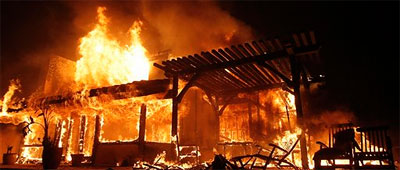Home Fire Safety
At home, in less than 30 seconds a small flame can become completely out of control and quickly rage into a major fire. Many of the materials, fabrics, and furniture in your home are susceptible to rapid development into a house fire. It only takes minutes for thick black smoke to fill a house or for it to become engulfed in flames. Most deadly fires occur in the home when people are asleep…
Here’s what you need to know:
The Heat Of A Fire
Heat is more threatening than flames. A fire’s heat alone can kill.
Room temperatures in a fire can be 100 degrees at floor level and rise to 600 degrees at eye level! Inhaling this super-hot air will scorch your lungs. This heat can melt clothes to your skin. In five minutes, a room can get so hot that everything in it ignites at once: this is called flashover.
The Pitch Black Of A Fire
You may think of a fire as bright, however, fire starts bright but quickly produces black smoke and complete darkness. Pitch Black. If you wake up to a fire you may be blinded, disoriented and unable to find your way around the home you’ve lived in for years…
Smoke And Toxic Gas Of A Fire
Smoke and toxic gases kill more people than flames do. Fire uses up the oxygen that you need to breathe, and produces smoke and poisonous gases that kill. Breathing even small amounts of smoke and toxic gases can make you drowsy, disoriented and short of breath. The odorless, colorless fumes can lull you into a deep sleep before the flames even reach your door. You may not wake up in time to escape…
Before a fire, create a fire escape plan
Find two ways to get out of each room. If the primary way is blocked by fire or smoke, you will need a second way out. A secondary route might be a window onto a neighboring roof or a collapsible ladder for escape from upper story windows (this may be very important to have in your bedroom – depending on your home layout). The following window escape ladder is widely considered to be the best for home use:
X-IT Emergency Fire Escape Ladder
Make sure that windows are not stuck, screens can be taken out quickly, and you may need a chair or something to be able to climb up and out.
Practice feeling your way out of the house, low to the floor in the dark or with your eyes closed.
Note: Sleep with the bedroom door closed.
Note: Always keep a fire extinguisher nearby and in the bedroom.
Note: When traveling and staying overnight somewhere other than your own home, consciously look around the premises and decide where and how you would escape a fire.
Dual Sensor Smoke Alarm
Be sure to have ‘dual sensor’ smoke alarms throughout the house. The following article describes why this is important:
Dual Sensor Smoke and Fire Alarm, and Why They Are The Best
Note: Smoke Alarms DO HAVE A SHELF LIFE
DURING A FIRE
Crawl low under any smoke to your exit – heavy smoke and poisonous gases collect first along the ceiling.
When the smoke alarm sounds, get out fast. You may have only seconds to escape safely.
If there is smoke coming around the door or blocking your door or first way out, use your second way out.
Smoke is toxic. If you must escape through smoke, get low and go under the smoke to your way out.
Before opening a door, feel the doorknob and door. If either is hot, leave the door closed and use your second way out.
If you open a door, open it slowly. Be ready to shut it quickly if heavy smoke or fire is present.
If your clothes catch fire, stop, drop, and roll – stop immediately, drop to the ground, and cover your face with your hands. Roll over and over or back and forth until the fire is out.
Question: Have any of you experienced a house fire or know someone who has?
What were the lessons learned?

